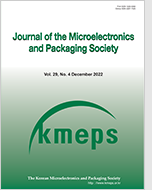
Search
- Past Issues
- e-Submission
-

KCI Accredited Journals KCI 등재지
KCI Impact Factor 0.54
Editorial Office
- +82-2-538-0962
- +82-2-538-0963
- kmeps@kmeps.or.kr
- http://kmeps.or.kr/

KCI Accredited Journals KCI 등재지
KCI Impact Factor 0.54
Journal of the Microelectronics and Packaging Society 2024;31(3):18-23. Published online: Oct, 29, 2024
DOI : doi.org/10.6117/kmeps.2024.31.3.018
Nanoimprint lithography (NIL) is widely used to form structures ranging from micro to nanoscale due to its advantage of generating high-resolution patterns at a low process cost. However, most NIL processes require the use of imprint resists and external elements such as ultraviolet light or heat, necessitating additional post-processes like etching or metal deposition to pattern the target material. Furthermore, patterning on flexible and/or non-planar films presents significant challenges. This study introduces an extreme pressure imprint lithography (EPIL) process that can form micro- /nano-scale patterns on the surface of a flexible rubber magnet composite (RMC) film at room temperature without an etching process. The EPIL technique can form ultrafine structures over large areas through the plastic deformation of various materials, including metals, polymers, and ceramics. In this study, we demonstrate the process and outcomes of creating a variety of periodic structures with diverse pattern sizes and shapes on the surface of a flexible RMC composed of strontium ferrite and chlorinated polyethylene. The EPIL process, which allows for the precise patterning on the surface of RMC materials, is expected to find broad applications in the production of advanced electromagnetic device components that require fine control and changes in magnetic orientation.
Keywords Imprint lithography, Rubber magnetic composition, Nanostructure, Nanopatterning